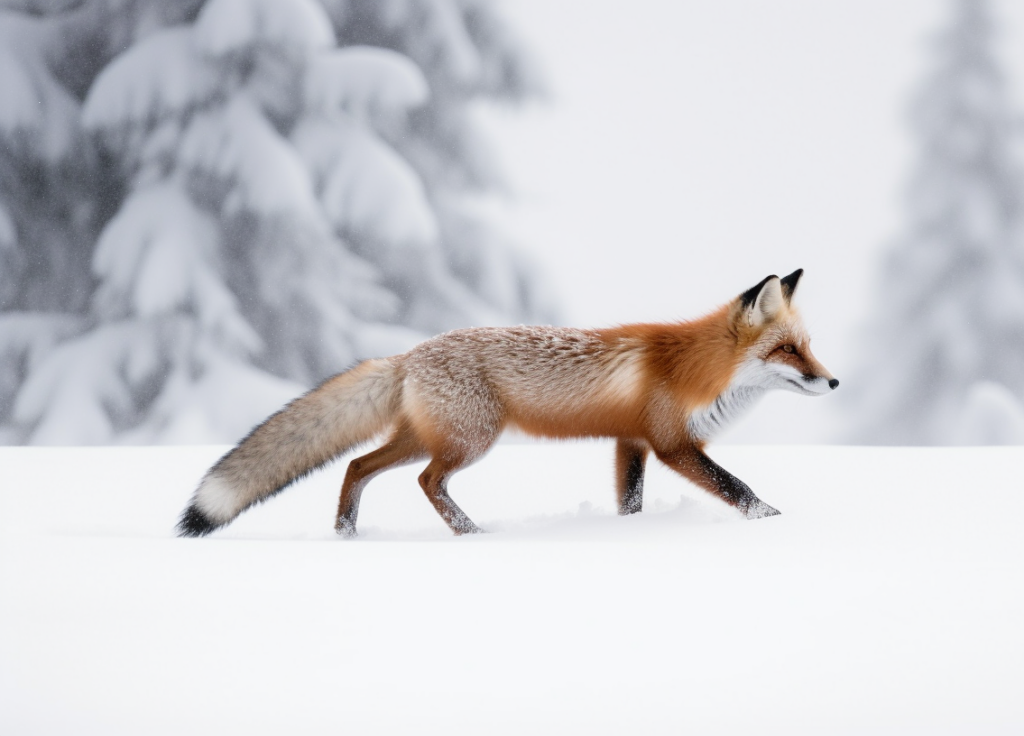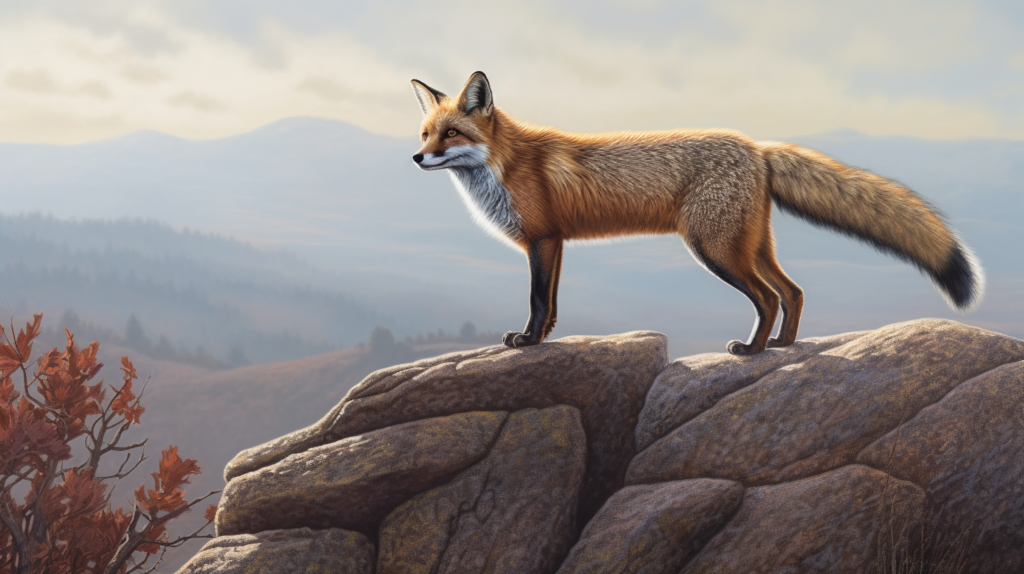The Red Fox, known scientifically as Vulpes vulpes, is an intriguing presence in the wild, captivating observers with its striking appearance and cunning behaviour. Characterised by its vibrant russet coat, bushy tail, and elongated body, this creature is the largest species within the true foxes. It exhibits pronounced sexual dimorphism, with the male, or dog fox, typically being larger than the female, or vixen. The foxes average at about 3.5 to 7 kilograms in weight, with bodies meticulously designed for agility and speed. These features are paramount to their survival in diverse habitats and their ability to evade predators and catch prey.
The red fox, a member of the Canidae family, is one of the most widely distributed carnivores on the planet. It has a natural range that spans multiple continents, from the colder regions of the Arctic to the hot deserts of Africa. Its striking appearance, coupled with its intelligence and adaptability, has earned the red fox a significant place in various cultures and folklore.
Distribution and Adaptability: Surviving in Diverse Habitats
The red fox’s adaptability is one of its most impressive traits. This animal can make a home in a range of habitats, from woodlands and grasslands to mountains and deserts. This ability to survive in diverse environments is a testament to the fox’s robust physiological and behavioural traits. Unlike the Arctic foxes and corsac foxes, which are adapted to specific climates, the red fox is a generalist, capable of thriving in both temperate and extreme conditions.
In the United States, for example, red foxes are found from the southernmost tip of Florida to the northernmost regions of Alaska. They endure the scorching heat of extreme deserts, as well as the bitter cold of Arctic regions. This adaptability has allowed the species to colonise a large part of the globe, with populations in North America, Europe, Asia, and even parts of Australia and North Africa. Their ability to adapt to changing environments, combined with a flexible diet, has enabled the red fox to inhabit urban areas as well, where they utilise human refuse and small pests as food sources.

The Red Fox’s Varied Diet: An Omnivorous Adaptation
One of the essential features contributing to the red fox’s adaptability is its varied diet. Unlike the Arctic foxes and corsac foxes, which have a more specialised diet, the red fox is omnivorous, consuming a wide range of food items. Their diet includes small mammals, birds, reptiles, amphibians, fish, invertebrates, fruits, berries, and even carrion. This broad diet allows them to adapt to changing food availability across different seasons and habitats, contributing significantly to their survival success.
In the autumn months, the red fox’s diet expands even further, perhaps in preparation for the lean winter months. During this season, they consume a variety of fruits and berries, supplementing their usual diet of small mammals and birds. They have been known to cache excess food, hiding it in the ground for later consumption, a behaviour that helps them survive during periods of food scarcity.
Skilled Hunters: Techniques and Behaviour
Red foxes are skilled hunters, employing a blend of stealth, speed, and acute hearing. They often resort to nocturnal hunting, using the cover of darkness to get close to their prey. Their hunting behaviour is characterised by a slow, careful approach, followed by a quick pounce. This method of hunting is highly effective for capturing small mammals and birds, which form the bulk of their diet.
However, their diet and hunting behaviour can change in response to human activities. When hunting pressure increases, or when their preferred prey becomes scarce, red foxes can switch to other food sources. They are known to scavenge in urban areas, foraging through rubbish bins and gardens for easy meals. This adaptability in their diet and hunting behaviour demonstrates the red fox’s impressive ability to survive and thrive in an ever-changing environment.
Observing a red fox hunt is a study in patience and precision. The body language they exhibit during these hunts is fascinating. They move cautiously, keeping their bodies low to the ground to avoid detection. Once they are within striking distance, they leap into the air, using their strong hind legs to propel themselves towards their prey.
Mating and Breeding Season: A Complex Ritual
The mating season for red foxes, usually occurring in the winter months, is marked by complex courtship behaviours. Potential mates engage in a variety of displays, including body language cues, scent marking, and vocalisations. Urine plays a significant role in these interactions. Differences in urine marking become more pronounced during the breeding season, with males marking more frequently than females.
The scent marks left by a fox carry a wealth of information about the individual, including their sex, age, and reproductive status. These signals are crucial for communicating with potential mates and rival foxes. Males use their scent marks to signal their dominance and to establish their territory. Meanwhile, females use scent marking to signal their fertility to potential mates. As the breeding season progresses, the frequency of scent marking increases, reaching a peak just before mating occurs.
Pregnancy and Cub Rearing: The Role of the Vixen
After successful mating, the vixen enters a gestation period of approximately seven weeks. She then gives birth to a litter of cubs, usually four to six in number. These cubs are born blind and helpless, entirely dependent on their mother for care and nourishment.
During the early weeks after birth, nursing vixens remain close to their dens, venturing out only to hunt for food. They are extremely protective of their offspring and will defend their den from intruders. At around four weeks of age, the cubs begin to emerge from the den and explore their surroundings. They are weaned at around eight to ten weeks of age, but they continue to stay with their mother and siblings until autumn, learning important skills such as hunting and defending their territory.
Human Interaction and Urban Adaptation
As the red foxes have moved into urban areas, they’ve had to adapt their behaviours and habits to survive. Often seen as pests, they scavenge for food in waste bins and gardens, adapting their diet to include more human-provided food sources. However, they still play an important role in these environments, controlling populations of rodents and other pests.
Despite this, they often face hunting pressure and persecution in many parts of their range. In response to this pressure, red foxes have been observed to modify their behaviour, becoming more nocturnal and elusive to avoid detection. This adaptability further underlines their resilience in the face of changing environments and pressures.

FAQ’s About The Red Fox
How does the red fox communicate with other members of its species?
Red foxes communicate with each other through a variety of methods, including body language, scent marking, and vocalisations. They use these methods to express dominance, signal fertility, and convey various other messages. These communication strategies are particularly vital during the breeding season.
What predators do red foxes have to watch out for?
Depending on their location, red foxes face predation from a variety of species. Common predators include large birds of prey, wolves, coyotes, and even larger felines in certain regions. Human activities, such as hunting and vehicular accidents, also pose significant threats.
How has the red fox adapted to urban environments?
Red foxes have shown remarkable adaptability in urban environments. They have adjusted their diet to include more human-provided food sources, scavenging in waste bins and gardens. Furthermore, they have also altered their behaviour to be more nocturnal and elusive, thereby avoiding detection in populated areas.
What are some unique characteristics of red fox cubs?
Red fox cubs are born blind and helpless, entirely dependent on their mother for the first few weeks of their life. They begin to explore their surroundings at around four weeks of age and are weaned at eight to ten weeks. The cubs stay with their mother until the autumn, learning essential survival skills during this time.
How do red foxes contribute to their ecosystem?
Red foxes are an integral part of their ecosystem. They help control populations of rodents and other pests, both in urban and rural environments. Additionally, they serve as prey for larger predators, thereby contributing to the ecological balance.
How does the red fox’s hunting technique change in response to human activities?
In regions with high human activity or hunting pressure, red foxes adapt their hunting behaviour and diet. They may switch to scavenging in urban areas, foraging through rubbish bins and gardens for food. This adaptability showcases their remarkable ability to survive in changing conditions.
Can red foxes be domesticated?
While there have been some instances of domestication, red foxes are inherently wild animals. They have specific needs that can be challenging to meet in a domestic setting. Furthermore, they can pose risks to other pets and people, particularly due to their predation instincts and potential to carry diseases.
What is the lifespan of a red fox?
In the wild, red foxes typically live up to 3-6 years. However, in captivity, where they are safe from predators and have consistent access to food, they can live up to 14 years.
Is the red fox a threatened species?
Despite pressures from hunting, habitat loss, and persecution in some areas, the red fox is not currently classified as threatened. Their adaptability and wide-ranging diet have allowed them to thrive in diverse environments across the globe.
Are red foxes solitary animals or do they live in groups?
Red foxes are generally solitary animals, particularly when it comes to hunting. However, they may form loose family groups during the breeding season and while rearing cubs. These groups typically disband in the autumn when the cubs become independent.
Conclusion: The Red Fox, An Enduring Survivor
The red fox’s tale is one of survival and adaptability. Whether it’s adjusting their diet to available food sources, mastering complex hunting techniques, or navigating the intricacies of mating and cub rearing, these creatures exhibit an impressive degree of flexibility and resilience.
Despite the challenges they face, from hunting pressure to habitat loss, red foxes continue to thrive in a variety of environments, from the harsh extremes of desert regions to the bustling heart of urban areas. Their presence is a testament to their tenacity and adaptability, attributes that are perhaps the most defining features of the red fox.
Sources and References
- Species – Fox – mammal.org.uk
- Voigt, D. R., & Macdonald, D. W. (1984). Variation in the spatial and social behaviour of the red fox, Vulpes vulpes. Acta Zoologica Fennica, 171, 261-265.
- Nowak, R. M. (2005). Walker’s Carnivores of the World. Johns Hopkins University Press.
Sam loves to learn about animals and their habitats. He has been a nature lover from a very young age, and has been writing papers and articles about wildlife for as long as he can remember.
